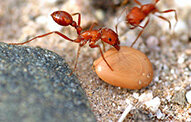Harvester Ants in Kansas City

Harvester ants are a diverse group of ants belonging to the genus Pogonomyrmex, comprising over 70 species found primarily in arid and semi-arid regions of North and South America. These ants are known for their remarkable foraging habits, impressive nest architecture, and potent defensive capabilities. Here’s a closer look at the habits and identification of harvester ants:
**Identification:**
Harvester ants are typically medium to large ants, with workers ranging in size from around 0.2 to 0.6 inches (5 to 15 millimeters) in length, depending on the species. They are characterized by their robust bodies, which are often reddish-brown, brown, or black in color. Harvester ants possess a distinctive feature known as a “spine” or “spur” on the posterior part of their bodies, which distinguishes them from other ant species.
These ants have well-developed mandibles adapted for cutting and carrying seeds, their primary food source. Harvester ants also have relatively large heads and powerful muscles, enabling them to transport heavy loads and excavate extensive underground tunnels.
**Habits:**
1. **Seed Harvesting:** As their name suggests, harvester ants are primarily seed harvesters. They forage individually or in groups, scouring their surrounding habitat for seeds, grains, and other plant materials. Once a suitable food source is located, harvester ants use their mandibles to cut and transport the seeds back to their nests.
2. **Nest Construction:** Harvester ants build elaborate underground nests consisting of interconnected tunnels and chambers. These nests can extend several feet below the surface and may house thousands of individuals, including workers, larvae, pupae, and a single queen. The structure of harvester ant nests plays a crucial role in regulating temperature and humidity levels, providing a suitable environment for colony survival.
3. **Defense Mechanisms:** Harvester ants are fiercely territorial and exhibit aggressive defense behaviors to protect their nests and foraging areas. When threatened, they will swarm intruders, delivering painful stings with their venomous stingers. The venom of harvester ants can cause significant pain and discomfort in humans, making them a formidable adversary.
4. **Seasonal Activity:** The activity of harvester ants is influenced by seasonal changes in temperature and rainfall. During periods of extreme heat or drought, harvester ants may reduce their foraging activity and retreat deeper into their nests to conserve moisture. Conversely, they may become more active during cooler, wetter conditions when food sources are more abundant.
In summary, harvester ants are remarkable insects known for their distinctive appearance, seed-harvesting behavior, and complex social structures. By understanding their habits and identifying key characteristics, individuals can better appreciate the ecological role of these fascinating ants in their native habitats.